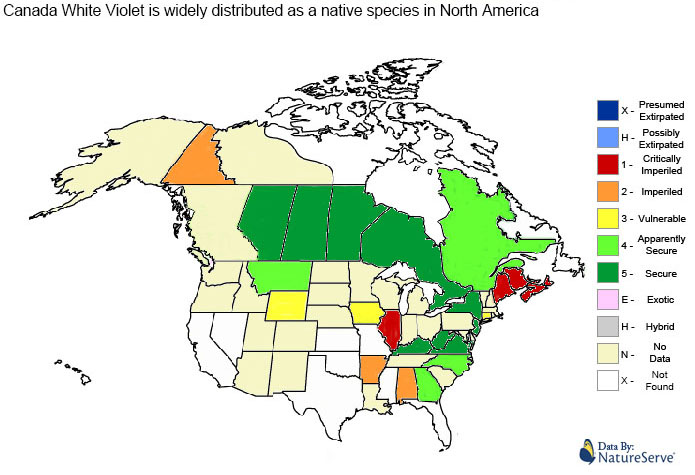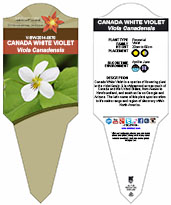

| Plant Name | Canada White Violet | |
| Scientific Name | Viola Canadensis | |
| Family | Violet | |
| Plant Type | Perennial | |
| Start of Blooming Season | April | |
| End of Blooming Season | June |

| Soil Conditions | |
| Soil Moisture | |
| Sunlight | |
| Notes: |

Canada White Violet is a perennial which grows 20cm to 60cm tall usually forming large colonies using underground stolons. The leaves are heart-shaped and alternate, 3cm to 10cm long. Flowers are white to pale violet with violet veins and a yellow throat. The flowers are 10mm to 25mm long with a sweet fragrance. Each flower contains five bilaterally symmetrical petals.

| Plant Height | 20cm to 60cm |
| Habitat | Moist Woods |
| Leaves | Cordate 3cm to 10cm long |
| Leaf Margin | Crenate |
| Leaf Venation | Palmate |
| Stems | Smooth stems |
| Flowering Season | April to June |
| Flower Type | Bilaterally Symmetrical |
| Flower Colour | White |
| Pollination | Bees, Insects |
| Flower Gender | Flowers are hermaphrodite and the plants are self-fertile |
| Fruit | Small capsule 8mm to 12mm long |
| USDA Zone | 4A (-31°C to -34°C) cold weather limit |

No known health risks have been associated with Canada White Violet. However ingestion of naturally occurring plants without proper identification is not recommended.

 |
-Click here- or on the thumbnail image to see an artist rendering, from The United States Department of Agriculture, of Canada white violet (This image will open in a new browser tab) |

Canada White Violet can be referenced in certain current and historical texts under the following two names: Canada White Violet can be translated into the following select languages: |
|||||||||||||
| Arabic | كندا أبيض، البنفسج | Bulgarian | Канада Бяла виолетка | Chinese (Sim) | 加拿大白色紫罗兰 | ||||||||
| Croatian | Kanada bijela ljubičasta | Czech | Kanada Bílá fialová | Danish | |||||||||
| Dutch | Esperanto | Kanada Blanka Violo | Estonian | Kanada valge violetne | |||||||||
| Finnish | Kanada Valkoinen Violetti | French | Violet blanc du Canada | German | Kanada Weiß Violett | ||||||||
| Greek | Hebrew | קנדה ויולט לבן | Hungarian | ||||||||||
| Italian | Canada Violetta bianca | Japanese | カナダホワイトバイオレット | Korean | 캐나다 화이트 바이올렛 | ||||||||
| Punjabi | ਕੈਨੇਡਾ ਵ੍ਹਾਈਟ ਵੈਂਟੀਲੇਟ | Lithuanian | Kanados balta violetinė | Norwegian | |||||||||
| Persian | کانادا سفید بنفش | Polish | Portuguese | Violeta branca do Canadá | |||||||||
| Romanian | Russian | Канада Белая фиалка | Slovak | Kanada Biela fialová | |||||||||
| Spanish | Violeta blanca de Canadá | Swedish | Tagalog | ||||||||||
| Turkish | Kanada Beyaz Menekşe | Ukrainian | Канада Біла фіалка | Vietnamese | |||||||||

| The information provided in this conservation assessment has been provided by the Natureserve Database in conjuction with various federal, provincial, state, county, district, regional, and municipal governments as well as public and private conservation authorities. Information in this section is accurate from the last time this article was updated. |
|
 |
Canada White Violet is considered to be a secure native species in North America. |

 |

 |
The MIROFOSS database offers free printable garden tags for personal and non-profit use. These tags can be used to properly identify plant samples in a garden. Click on the tags shown on the the screen or -click here- to download a full size jpeg image for a Canada White Violet identification tag; which can be printed on paper or used with a plastic laser printer. |
 |
What's this? What can I do with it? |

| Description | Dickinson, T.; Metsger, D.; Bull, J.; & Dickinson, R. (2004) ROM Field Guide to Wildflowers of Ontario, Royal Ontario Museum, Toronto:McClelland and Stewart Ltd. |
| Description | Kartesz, J.T. 1994. A synonymized checklist of the vascular flora of the United States, Canada, and Greenland. 2nd edition. 2 vols. Timber Press, Portland, OR. |
| Description | Horn, Cathcart, Hemmerly, Duhl, Wildflowers of Tennessee, the Ohio Valley, and the Southern Appalachians, Lone Pine Publishing, (2005) p 96, ISBN 978-1-55105-428-5 |
| Folklore | Hoffman, W.J., 1891, The Midewiwin or 'Grand Medicine Society' of the Ojibwa, SI-BAE Annual Report #7, page 201 |
| Image Rendering | USDA-NRCS PLANTS Database / USDA NRCS. Wetland flora: Field office illustrated guide to plant species. USDA Natural Resources Conservation Service. |
| Environment | National Audubon Society. Field Guide To Wildflowers (Eastern Region): Alfred A. Knopf. ISBN 0-375-40232-2 |
| Physical Identification | National Audubon Society. Field Guide To Wildflowers (Eastern Region): Alfred A. Knopf. ISBN 0-375-40232-2 |
| January 01, 2018 | The last time this page was updated |
| ©2021 MIROFOSS™ Foundation | |
 |